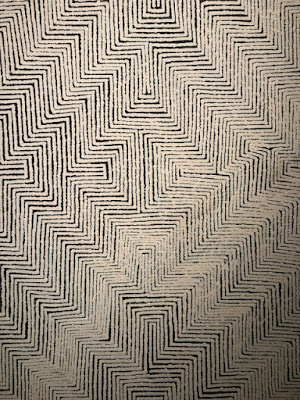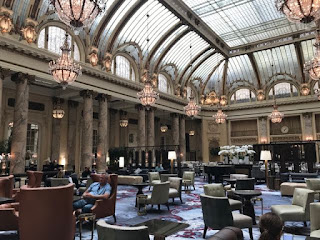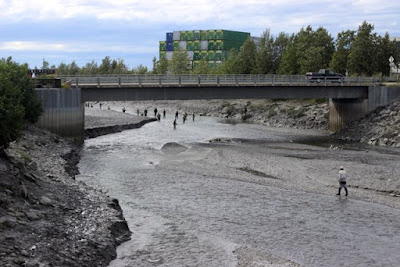Rachel Epstein has been doing her part to make UAA a real university campus where people come together and talk about ideas.
Her bookstore lectures regularly present interesting speakers on an array of topics in an intimate setting where the audience gets to interact with the speakers, many of whom are UAA faculty.
So I'm just copying her latest email listing what's coming, starting tomorrow and going through February. They are all in the campus bookstore (between the old Sports Complex and the Student Center) and parking is free on Providence Drive just east of Lake Otis. If for any reason you get a ticket, Rachel will take care of it for you.
The lectures will eventually get up as podcasts to join the
ones already up.
Thursday, January 25 from 5:00 pm-7:00 pm Krista Oke presents (Non) Parallel Evolution and Alaska Salmon
Krista Oke is a postdoctoral researcher in the Department of Ecology and Evolutionary Biology at University of California Santa Cruz. Her research interests include human-influenced evolution and repeated habitat-associate evolution (or parallel evolution) in fishes. She received her PhD from McGill University, Montreal.
At this event, Krista Oke will explore what salmon can tell us about the forces that shape evolution, focusing on beach and creek spawning forms of sockeye salmon and even-year and odd-year pink salmon. In addition, she will discuss recent declines in the size and age of Alaska salmon, and look for similarity among species and regions in patterns of change.
Monday, January 29, 2018 from 5:00 pm-7:00 pm
Forrest A. Nabors presents From Oligarchy to Republicanism: The Great Task of Reconstruction
In his new book From Oligarchy to Republicanism, Forrest A. Nabors sets out to show how congressional Republicans regarded the work of Reconstruction in the same way they regarded the work of the Founders: as regime change, from monarchy in the one case and from oligarchy in the other, to republicanism. By examining congressional writings and speeches from 1863-1869, Forrest A. Nabors offers a critical analysis of Reconstruction and the nature of Southern oligarchy.
“In this unique perspective on Reconstruction, the political scientist Forrest A. Nabors offers new insights on how the Republicans of the Civil War era drew upon their portrayal of the conflict between freedom and slavery as a struggle between republicanism and oligarchy to shape their program of Reconstruction.” -- Renowned Civil War historian James McPherson, author of Battle Cry of Freedom
“If you want to understand the origins of the Civil War, why the North won, the outcome’s consequences for this country, and race relations over the last 150 years, this book is the place to start. It is a masterpiece, and it is going to have an immense impact.” -- Paul A. Rahe, author of Republics Ancient and Modern: Classical Republicanism and the American Revolution
Forrest A. Nabors is Associate Professor and Chair of the Dept. of Political Science at UAA. He received his PhD from University of Oregon.
Tuesday, January 30 from 5:00 pm-7:00 pm Kim Patterson presents Becoming Visible: Social Justice by the Hands of Faith-based and Grassroots Organizations
Dr. Kim Patterson is former director of UAA Student Support Services, which served first generation, nontraditional, and veteran students returning to school. He is author of Embracing the Homeless Community and the book Swift Justice: Leveling the Playing Field for America’s Re-entry Citizens. With a commitment to renewal initiatives within social and faith-based communities, he founded Connections Alaska, Inc.
Monday, February 5 from 5:00 pm-7:00 pm
Let Your Memoir Be Your Resistance: How Booker Wright's granddaughter turned his story, and her journey to uncover it, into American History
In 2011, Yvette Johnson traveled back to Greenwood, Mississippi–home of the Emmett Till murder and home of the man convicted of slaying Medgar Evers–to uncover true the story of her late grandfather Booker Wright. Booker Wright spent his evenings waiting tables for Whites at a local restaurant and his mornings running his own business. In the 1966 NBC interview and documentary Mississippi: A Self-Portrait, his remark, “Have to keep that smile,” sent shock waves throughout America. And what life was truly like for Black people of Greenwood, Mississippi finally received national attention.
Four decades later, Yvette Johnson uncovered footage of the controversial documentary. Oddly, no one in her family knew of his television appearance. Even more curious for Yvette was that for most of her life she had barely heard mention of her grandfather’s name or stories explaining his murder. Due to this silence, and her own struggles with race and identity, Yvette Johnson decided to honor the memory of Booker Wright and write The Song and the Silence: A Story about Family, Race, and What Was Revealed in a Small Town in the Mississippi Delta While Searching for Booker Wright.
Yvette Johnson currently works as the Executive Director of The Booker Wright Project. In this role, she creates and facilitates workshops on unconscious bias and privilege.
This event is sponsored with the UAA Dept. of Sociology, UAA Student Affairs, and UAA Diversity Action Council.
Tuesday, February 6 from 5:00 pm- 7:00 pm On the Frontiers of an Inner Life: Kathleen W. Tarr presents Thomas Merton's 1968 Journey to Alaska
Author Kathleen W. Tarr discusses her newly released book, We Are All Poets Here (VP&D House, 2018). Part memoir, part biography, with Thomas Merton as the spiritual guide, the quest to seek an interior life amidst a chaotic, confused, fragmented world is explored.
Trappist Thomas Merton (1915-1968) lived as a sequestered monastic for 27 years. However, he wrote over fifty books and hundreds of poems and articles on topics ranging from monastic spirituality to civil rights, nonviolence, and the nuclear arms race. Today, his 1948 autobiography, The Seven Storey Mountain, continues to influence millions of people all over the world. After his surprise sojourn to Alaska in 1968, Thomas Merton traveled to Thailand where he met his accidental and shocking death by electrocution.
Author Kathleen W. Tarr was born and raised in Pittsburgh. She came to Alaska in 1978 and lived in Yakutat, Sitka, and the Kenai Peninsula, and was Program Coordinator for UAA's MFA Graduate Creative Writing Program. She earned an MFA in Creative Writing from The University of Pittsburgh and has writings published in several anthologies and in Creative Nonfiction, the Sewanee Review, Alaska Airlines Magazine, the Anchorage Daily News, TriQuarterly, Sick Pilgrim, and Cirque.
In 2016, she was named a William Shannon Fellow by the International Thomas Merton Society. Currently, she sits on the board of the Alaska Humanities Forum.
New event: Thursday, February 8 from 5:00 pm-7:00pm Trita Parsi presents What is Happening in Iran?
Trita Parsi is President of the National Iranian American Council and is the 2010 recipient of the prestigious Grawemeyer Award for Ideas Improving World Order. He is the author of Losing an Enemy: Obama, Iran and the Triumph of Diplomacy (2017); A Single Roll of the Dice: Obama’s Diplomacy with Iran (2012); and Treacherous Alliance: The Secret Dealings of Israel, Iran, and the United States (2007).
A frequent guest on CNN, PBS’s Newshour with Jim Lehrer, NPR, the BBC, and Al Jazeera, his articles on Middle East affairs have appeared in the Washington Post, Wall Street Journal, New York Times, Los Angeles Times, Financial Times, Jane’s Intelligence Review, the Nation, The American Conservative, the Jerusalem Post, The Forward, and others.
Trita Parsi holds a PhD from Johns Hopkins’ School for Advanced International Studies and currently teaches at the Edmund A. Walsh School of Foreign Service at Georgetown University.
Saturday, February 10 from 1:00 pm-3:00 pm
Camilla Kennedy presents Thinking About Environmental Economics in Alaska
What is Environmental Economics and why does it matter in Alaska? This presentation will get you thinking like an Environmental Economist. Topics introduced include environmental externalities, Total Economic Value (TEV) of natural resources and ecosystems, and understanding the interactions between our economic system and environment.
Camilla Kennedy currently teaches Environmental Economics and Policy at UAA and works at the Alaska Department of Environmental Conservation on regulatory policy analysis and also conducts research on environmental policies. She received her BA in Economics from UAF and her Masters in Environmental Economics and Climate Change from the London School of Economics.
Everyone is invited to attend this event. There is free parking at UAA on Saturdays.
Monday, February 19 from 5:00 pm-7:00 pm United States' Role in the Arctic and What Alaskans Need to Know about Plans and Future Developments
[UPDATE 3:49 pm - I got notice that Laswon Brigham won't be able to attend and that Dalee Sambo will take his place.]
Notable guest speakers [Dalee Sambo] Lawson Brigham, Randy “Church” Kee, and Darren Prokop come together to share their views about Alaska and the changing Arctic.
[Dalee Sambo Dorough is Associate Professor of Political Science at UAA and specializes in international law, international human rights law, Indigenous human rights standards, and the status and human rights of Alaska Natives. She holds a PhD from the University of British Columbia, Faculty of Law and a Master of Arts in Law & Diplomacy from the Fletcher School at Tufts University. Her writings include International Law Association’s Expert Commentary of the Committee on Rights of Indigenous Peoples: http://www.ila-hq.org/en/committees/index.cfm/cid/1024] and United Nation’s Permanent Forum in Indigenous Issues’ Statement on the Dakota Access Pipeline. The present focus of her research relates to Arctic Indigenous peoples and their views on shipping, food security, cultural rights, and other Arctic specific issues.]
Lawson W. Brigham is Faculty and Fellow at the International Arctic Research Center, University of Alaska Fairbanks. He was chair of the Arctic Council’s Arctic Marine Shipping Assessment (2005– 9) and previously was a career US Coast Guard officer who commanded four ships, including the polar icebreaker Polar Sea. He is a graduate of the U.S. Coast Guard Academy (BS), a distinguished graduate of the U.S. Naval War College, and holds graduate degrees from Rensselaer Polytechnic Institute (MS) and the University of Cambridge (MPhil & PhD)]
Randy “Church” Kee, Major General USAF (Ret.) had an impressive 30-year career in the U.S. Air Force. He is a career pilot and possesses three graduate degrees. In 2016, he became the Executive Director of the Arctic Domain Awareness Center--a U.S. Department of Homeland Security, Center of Excellence, hosted by the University of Alaska. At the Center, he leads an interdisciplinary team of 40 university and industry researchers to develop and transition technologies, innovate products and educational programs in order to improve crisis response capabilities related to emerging maritime challenges posed by the dynamic Arctic environment
Darren Prokop is Professor of Logistics at UAA. He has published research in leading academic journals with topics ranging from: cabotage regulations; air cargo logistics; and supply chain security modelling. Prior to his academic career, he worked in government as an economist and in the private sector in inventory planning. He is author of numerous books including Global Supply Chain Security and Management: Appraising Programs, Preventing Crimes (2017), Concepts of Transportation Economics (2016), and The Business of Transportation (2014). He holds a PhD in Economics from the University of Manitoba.
Monday, February 26 from 5:00 pm-7:00 pm
Shuvajit Bhattacharya presents Fluid Storage and Induced Earthquakes
Dr. Shuvajit Bhattacharya teaches in the Department of Geological Sciences at UAA. His current research areas are in energy geosciences, geophysics, petrophysics, induced seismicity, and predictive data analytics . Prior to joining UAA, he worked in a few oil and gas companies and completed multiple projects for energy exploration and fluid storage, and utilization in North America, Australia, South Africa, and India.
What is the causal the relationship between fluid storage and human induced earthquakes is the focus of this event.
Tuesday, February 27 from 5:00 pm-7:00 pm Hugh Gunner Deery III presents Buddhist Epistemology
Buddhist Epistemology is the branch of philosophy concerned with the nature and study of knowledge. At this event, types of knowing linked to Buddhist concepts of self, mental cognition, dependent origination, and causation will be explained.
Hugh Deery Gunner III teaches Intro to Philosophy, Logic, and Ancient and Medieval philosophy in the Philosophy Dept. at UAA. He received a BA in philosophy at Grand Valley State University (Grand Rapids, MI) and an MA in philosophy from Colorado State University (Fort Collins, CO). His focus of study centered on Eastern Philosophy, Political Philosophy, Linguistics and Ethics.
.
All UAA Campus Bookstore events are free and open to the public. There is free parking for this event in the South Lot, Sports Complex NW Lot, West Campus Central Lot, and Sports Campus West Lot.















































